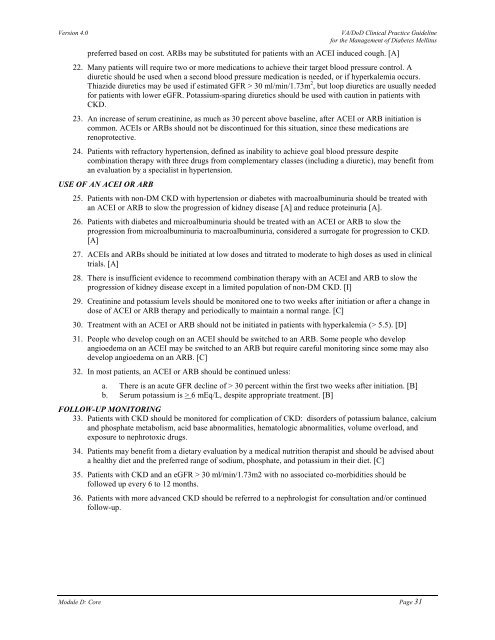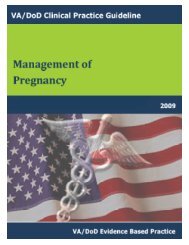DM Full Guideline (2010) - VA/DoD Clinical Practice Guidelines Home
DM Full Guideline (2010) - VA/DoD Clinical Practice Guidelines Home
DM Full Guideline (2010) - VA/DoD Clinical Practice Guidelines Home
Create successful ePaper yourself
Turn your PDF publications into a flip-book with our unique Google optimized e-Paper software.
Version 4.0<br />
<strong>VA</strong>/<strong>DoD</strong> <strong>Clinical</strong> <strong>Practice</strong> <strong>Guideline</strong><br />
for the Management of Diabetes Mellitus<br />
preferred based on cost. ARBs may be substituted for patients with an ACEI induced cough. [A]<br />
22. Many patients will require two or more medications to achieve their target blood pressure control. A<br />
diuretic should be used when a second blood pressure medication is needed, or if hyperkalemia occurs.<br />
Thiazide diuretics may be used if estimated GFR > 30 ml/min/1.73m 2 , but loop diuretics are usually needed<br />
for patients with lower eGFR. Potassium-sparing diuretics should be used with caution in patients with<br />
CKD.<br />
23. An increase of serum creatinine, as much as 30 percent above baseline, after ACEI or ARB initiation is<br />
common. ACEIs or ARBs should not be discontinued for this situation, since these medications are<br />
renoprotective.<br />
24. Patients with refractory hypertension, defined as inability to achieve goal blood pressure despite<br />
combination therapy with three drugs from complementary classes (including a diuretic), may benefit from<br />
an evaluation by a specialist in hypertension.<br />
USE OF AN ACEI OR ARB<br />
25. Patients with non-<strong>DM</strong> CKD with hypertension or diabetes with macroalbuminuria should be treated with<br />
an ACEI or ARB to slow the progression of kidney disease [A] and reduce proteinuria [A].<br />
26. Patients with diabetes and microalbuminuria should be treated with an ACEI or ARB to slow the<br />
progression from microalbuminuria to macroalbuminuria, considered a surrogate for progression to CKD.<br />
[A]<br />
27. ACEIs and ARBs should be initiated at low doses and titrated to moderate to high doses as used in clinical<br />
trials. [A]<br />
28. There is insufficient evidence to recommend combination therapy with an ACEI and ARB to slow the<br />
progression of kidney disease except in a limited population of non-<strong>DM</strong> CKD. [I]<br />
29. Creatinine and potassium levels should be monitored one to two weeks after initiation or after a change in<br />
dose of ACEI or ARB therapy and periodically to maintain a normal range. [C]<br />
30. Treatment with an ACEI or ARB should not be initiated in patients with hyperkalemia (> 5.5). [D]<br />
31. People who develop cough on an ACEI should be switched to an ARB. Some people who develop<br />
angioedema on an ACEI may be switched to an ARB but require careful monitoring since some may also<br />
develop angioedema on an ARB. [C]<br />
32. In most patients, an ACEI or ARB should be continued unless:<br />
a. There is an acute GFR decline of > 30 percent within the first two weeks after initiation. [B]<br />
b. Serum potassium is > 6 mEq/L, despite appropriate treatment. [B]<br />
FOLLOW-UP MONITORING<br />
33. Patients with CKD should be monitored for complication of CKD: disorders of potassium balance, calcium<br />
and phosphate metabolism, acid base abnormalities, hematologic abnormalities, volume overload, and<br />
exposure to nephrotoxic drugs.<br />
34. Patients may benefit from a dietary evaluation by a medical nutrition therapist and should be advised about<br />
a healthy diet and the preferred range of sodium, phosphate, and potassium in their diet. [C]<br />
35. Patients with CKD and an eGFR > 30 ml/min/1.73m2 with no associated co-morbidities should be<br />
followed up every 6 to 12 months.<br />
36. Patients with more advanced CKD should be referred to a nephrologist for consultation and/or continued<br />
follow-up.<br />
Module D: Core Page 31
















